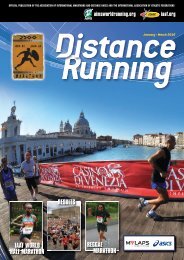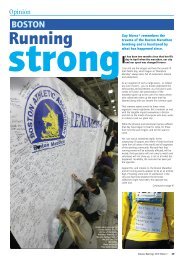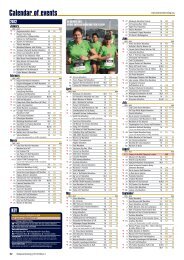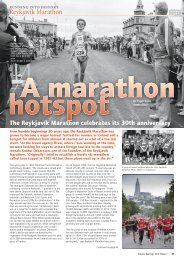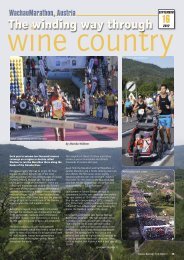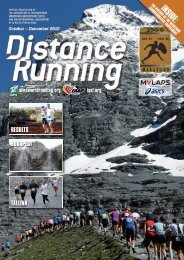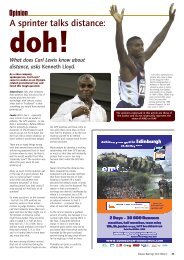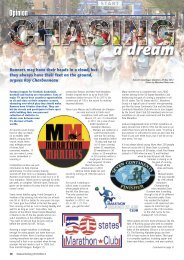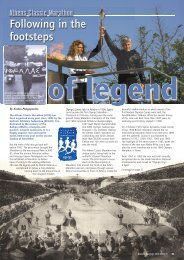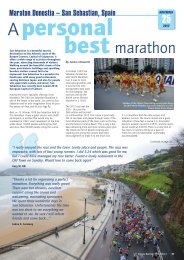Download pdf - Distance Running magazine
Download pdf - Distance Running magazine
Download pdf - Distance Running magazine
- No tags were found...
Create successful ePaper yourself
Turn your PDF publications into a flip-book with our unique Google optimized e-Paper software.
You are what you runThe UWI SPEC International Half Marathon, Trinidad and Tobago42006NOVEMBERBy Elizabeth Walcott-Hackshaw“What do you do?” or “what areyou?” are simple questions butoften seem indiscreet, or even rude.But I am interested to hear the firstthing that a person says. I say thatI’m a lecturer in French Literature atthe University of the West Indies.“That’s nice” is the usual response,followed by a polite smile and aquick end to the conversation.French Literature does not attract amass following.But if you say “I’m a runner” (evenan ordinary runner) it would besure to generate a discussion. For along time I didn’t think I hadearned that right. I came to thesport late in life although I did havethe occasional jog along the CharlesRiver and through the back roadsof Brookline as a student in Boston.But I thought that to call yourself arunner you had to conquer somemajor race. The title had to beearned, I felt, just like a degree.The 5K races I ran in were a start,and I did quite a few of those untilI began to run with “real runners”in half- marathons and marathons.The UWI Half-Marathon was oneof the races that earned me theright to be called a runner. It is aspecial race for me because I teachat the institution, I know membersof the committee who organize therace and I know how much efforthas gone into this three-year-oldevent. From the moment it wasannounced that the University, forthe first time in its history, wouldbe hosting a half marathon I knew Ihad to take part.The first race, in November 2004,started at 07.00. The sun wasalready up and those of us runningthe race were hot from beginning toend, almost boiling over by the timewe completed the course. The slowtimes testified to the temperature,but even though we suffered in thehot sun we could still appreciatehow well the race was organizedand how much attention was paidto ensure that we were given atraffic-free route.That may seem strange to thosewho run marathons in othercountries but here in Trinidad andTobago runners must oftennegotiate both the competition andthe cars. Being on the run andassured of your safety fromoncoming vehicles is not somethingwe take for granted. While enjoyingthe fruits and the banquet of localspecialities provided for us at thefinish some of us suggested thatthat the race should in fact startearlier. The organisers listened, andthe next year we set off at 06.00.I was there, ready to take partagain. The earlier start meant thatwe needed to get to SPEC, thenewly built University sports centre,at 05.00. There is always a greatfeeling before the start of a race,particularly when it is still dark.Around race time the sun rises at05.45 and I enjoy the short-livedfreedom the cover of darknessbrings before all is revealed at thestarting line.Trinidad and Tobago is not a bigplace and the more you run themore you begin to recognize thefaces of other runners. The moreyou race the more you begin toremember the times of the toprunners. You begin to recognize theones you will not see again until thefinish line and those you hope tostay with or even outrun. Theanonymity that one may feel inother countries is not part of ourisland running experience. Becausethe running community is small ourdifferences are always wonderfullyapparent: age, class, race ethnicgroup, religious affiliation, politicalaffiliation, nationality - we are allthere on the line. We are all readyto test ourselves and be tested bythe course, the conditions and ourfellow competitors.This year the half marathon coursetested nearly 600 of us. This is bigfor a race in Trinidad and Tobago,on par with our long-establishedlocal marathon. The UWI halfmarathonhas reached out and nowattracts international runners, likethe 2005 winners John MuriethiMuriuki from Kenya and theRussian Firaya Sultanova-Zhdanova. Top regional runnerslike Pamenos Ballantyne and CurtisCox also participate; and studentsare beginning to come in fromother university campuses in theWest Indies. But the most runnerscome from Trinidad and Tobago.I recognize many of the faces that Isee doing laps around the Queen’sPark Savannah on a Saturday orSunday morning. These runnersstart to talk to you simply becausethey have seen you run in the rain,before sunrise, or after a hard dayat work. Names are not importantand the question “what do youdo?” seldom comes up becausewhat we all do is run. A friendlyteasing takes place as we stretch,drink a cold Gatorade or coldcoconut water cut there and thenby a coconut vendor. Some of mybest Saturday mornings havestarted this way with a long run;some banter and a quiet sense ofcommunity that comes from<strong>Distance</strong> <strong>Running</strong> January – March 200725



